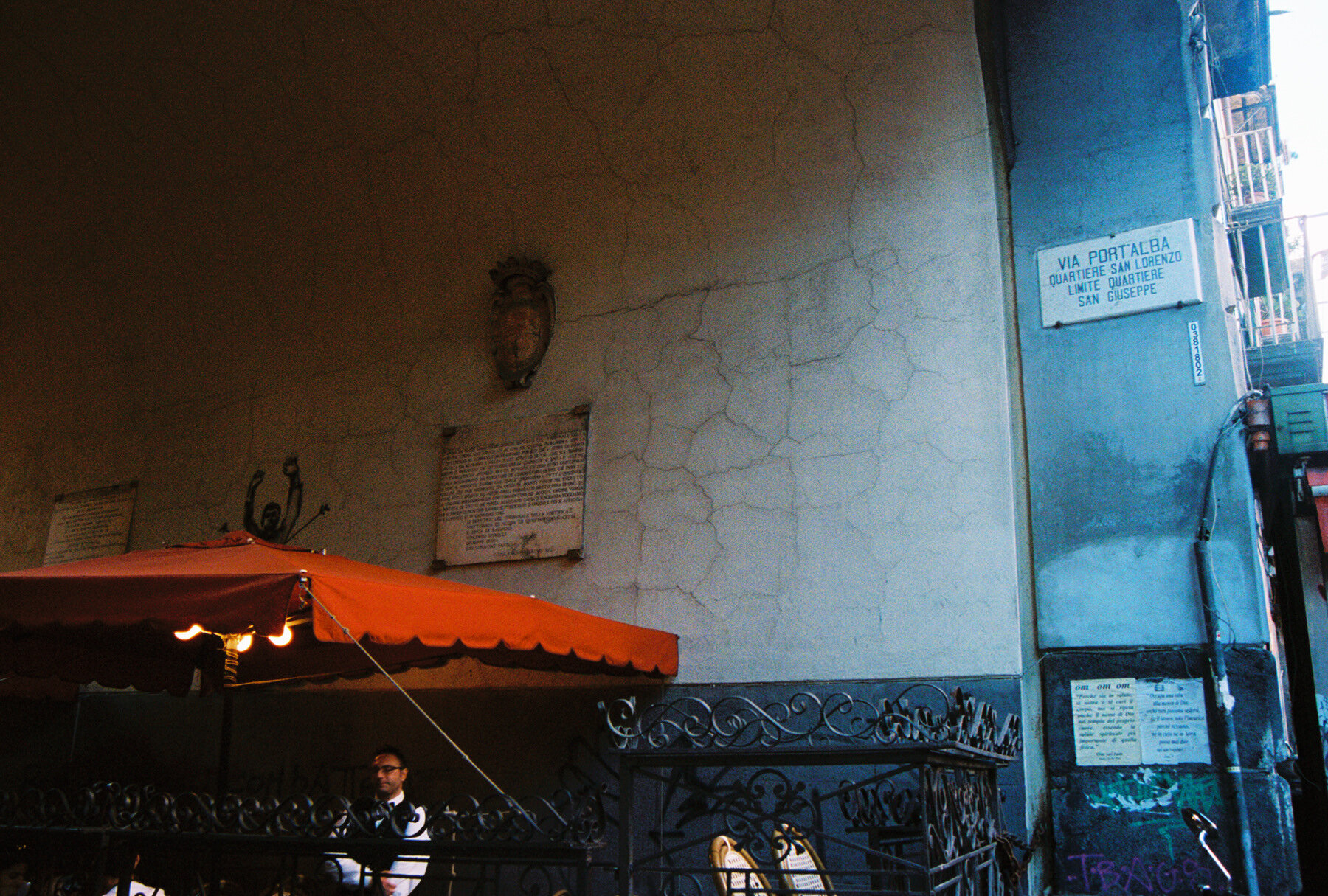The sun finds it way through the velvet black shadows. Posters advertise operas I won’t get to see. Padre Pio forever in the background, his face found in taxi cabs, on walls, in churches, in caffes. Chiaroscuro lighting from sunlight mixed with shadows. My Rian, he’ll remain beautiful forever in the sun here.
Hanging bronze dye pasta, bufalo mozzarella from campania, rows of inviting rum-soaked baba cakes filled with rummy yellow cream, tiny wild strawberries, Sfogliatelle.
Stunning churches, colorful architecture, dark and ancient looking alleyways filled with street theatre and trash on the street… the extremes of modern Napoli.
A baroque awning, layers of brick from different centuries, buildings and façades built on top of each other, a neapolitan girl on her mobile, another caffe beckoning the passersby.
Hanging fruit and ripe red campania tomatoes and an early pasieggetta.
Ancient pillars in residential neighborhoods, forming millennia old foundations.
Another beautiful church front and a charming caffe.
Bursts of color and brightness and the scent of glorious coffee floating in the air at every turn.
I always seem to find the caffes… I always feel like I’m on some unspoken mission to drink the best coffee.
When the little girl walked by I knew I had to capture her in that moment of contrasts and colors.
There is so much to see, just to read on the walls.
I like when the graffiti becomes art.
Back to this fellow. I remember his likeness on other walls on other visits to Naples.
Mirrors and antiques and the scrawlings every where.
A delightful music shop.
Spaccanapoli, the old Greek section of Napoli, Italy is a recurring fascination of mine.
A closed boulangerie with a broom leaning against the store front. Painted pastoral scenes on plates. Rusted piping and peeling posters. Grafitti in bright colors.
Caffe chairs sprinkled throughout the back streets of Spaccanapoli.
Two “lovers” embracing in front of an iconic “second hand shop” full of Neapolitan treasures overseen by a curious little dog.
The simple cafe tables and chairs in front of artisan shops and caffes with a sculpture of an old man in the background.
Every day life in an alleyway; people, a truck delivering goods, empty vegetable and fruit crates, the golden mustard apartments and hanging laundry.
I love the corners and crevices and surprising bursts of yellow in between the rust.
The quintessential graffiti of Naples, as ancient as the tags and scribblings on Pompeiian walls.
The old guard and the ‘new art’.
More graffiti, and the vespas and cars and Neapolitans seem all the more nonchalant about it.
A whole street filled with beautiful second hand and rare book shops and musical instruments and conservatories. I never wanted to leave.
A gorgeously appointed restaurant, intimate, and romantic in a baroque neapolitan way. I could have lingered for hours with a glass of nero d’avola and flirted, but I had less than a day to shoot Naples because of all the rain prior to this day.
This is a wider shot of the restaurant. It looks like an opening to another, older world. I told you it was beautiful.
Even the scribbles are a crying out and bleed every color onto wood and stone and brick.
The priest or monk, graffiti iconography and protest.
I found this hollowed out frame and the lettering and font (name of the one time King) very delicate and beautiful looking.
I know Napoli isn’t for everyone. I know street grafitti on historical buildings can be a bit of a shock. But once you visit Naples a few times and fall into the rhythm of the city and of its people, the fright wears off and you begin to see the color is all the more bright in contrast to the shadows. If you are like me and find beauty in decaying things and centuries of history piled up on top of each other, you may just find yourself falling in love with the heart stealer of baroque Napoli.
All photographs shot on portra 400 and 800 – 35mm film. Shot in the Spring of 2013.
































